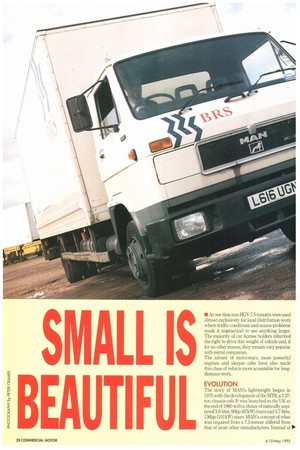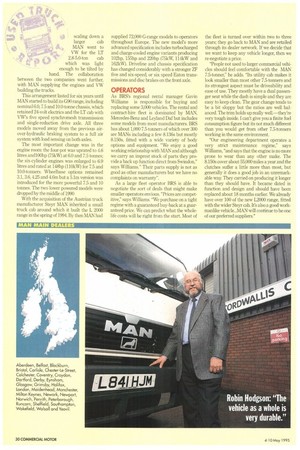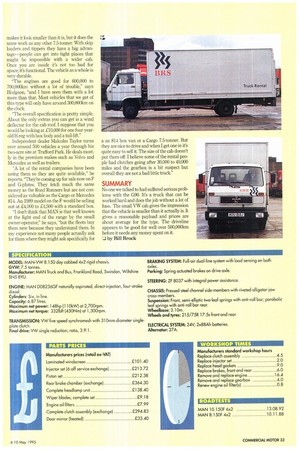la At one time non-HGV 7.5-tonners were used almost exclusively
Page 30

Page 32

Page 33

Page 34

Page 35

If you've noticed an error in this article please click here to report it so we can fix it.
for local distribution work where traffic conditions and access problems made it impractical to use anything larger. The majority of car license holders inherited the right to drive this weight of vehicle and, if for no other reason, they remain very popular with rental companies.
The advent of motorways, more powerful engines and sleeper cabs have also made this class of vehicle more acceptable for longdistance work.
EVOLUTION
The story of IVIAN's lightweight began in 1975 with the development of the MTh, a 7.37ton chassis-cab. It was launched in the IJK at the end of 1980 with a choice of naturally aspirated 3.8-litre, 90hp (67kW) fours and 5.7-litre, 136hp (101kW) sixes. MAN's concept of what was required from a 7.5-toriner differed from that of most other manufacturers. Instead of 111° tt scaling down a
larger cab MAN went to VW for the LT 2.8-5.0-ton cab which was light enough to be tilted by hand. The collaboration between the two companies went further, with MAN supplying the engines and VW building the trucks.
This arrangement lasted for six years until MAN started to build its G90 range, including nominal 6.0,7.5 and 10.0-tonne chassis, which retained 24-volt electricN and the LT cab with VW's five speed synchromesh transmission and single-reduction drive axle. All three models moved away from the previous airover-hydraulic braking system to a full air system with load sensing on both axles.
The most important change was in the engine room: the four-pot was uprated to 4.6 litres and100hp (75kW) at 6.0 and 7,5 tonnes; the six-cylinder engines was enlarged to 6.9 litres and rated at 148hp (110kW) for 75 and 10.0-tonners. Wheelbase options remained 3.1, 3.6, 4.25 and 4.6m but a 5.1m version was introduced for the more powerful 7.5 and 10 tonnes. The two lower powered models were dropped by the middle of 1990 With the acquisition of the Austrian truck manufacturer Steyr MAN inherited a small truck cab around which it built the L 2000 range in the spring of 1994. By then MAN had supplied 72,000 G-range models to operators throughout Europe. The new model's more advanced specification includes turbocharged and charge-cooled engine variants producing 102hp, I55hp and 220hp (75kW, 114kW and 162kW). Driveline and chassis specification has changed considerably with a stronger ZF five and six-speed, or six speed Eaton transmissions and disc brakes on the front axle.
OPERATORS
As BRS's regional rental manager Gavin Williams is responsible for buying and replacing some 3,000 vehicles. The rental and contract-hire fleet is dominated by MAN, Mercedes-Benz and Leyland Daf but includes some models from most manufacturers. BRS has about 1,000 7.5-tonners of which over 300 are MANs including a few 8.136s but mostly 8.150s, fitted with a wide variety of body options and equipment. "We enjoy a good working relationship with MAN and although we carry an imprest stock of parts they provide a back up function direct from Swindon," says Williams." Their parts supply is not as good as other manufacturers but we have no complaints on warranty".
As a large fleet operator BRS is able to negotiate the sort of deals that might make smaller operators envious, "Prices are competitive," says Williams. "We purchase on a tight regime with a guaranteed buy-back at a guaranteed price. We can predict what the whole life costs will be right from the start. Most of
the fleet is turned over within two to three years; they go back to MAN and are retailed through its dealer network. If we decide that we want to keep any vehicle longer, then we re-negotiate a price.
"People not used to larger commercial vehicles should feel comfortable with the MAN 7.5-tonner," he adds. "Its utility cab makes it look smaller than most other 7.5-tonners and its strongest aspect must be driveability and ease of use. They mostly have a dual passenger seat while the dash is simple and they are easy to keep clean. The gear change tends to be a bit sloppy but the ratios are well balanced. The trim holds up really well.—they're very tough inside. I can't give you a finite fuel consumption figure but its not much different than you would get from other 7.5-tonners working in the same environment.
"Our engineering department operates a very strict maintenance regime," says Williams, "and says that the engine is no more prone to wear than any other make. The 8.150s cover about 55,000 miles a year and the clutches suffer a little more than most, but generally it does a good job in an unremarkable way. They carried on producing it longer than they should have. It became dated in function and design and should have been replaced about 18 months earlier. We already have over 100 of the new L2000 range, fitted with the wider Steyr cab. It's also a good workmanlike vehicle...MAN will continue to be one of our preferred suppliers." John Holt is transport manager for international haulier Laser Transport, which has been based at the Lympne industrial estate near Folkestone for 12 of its 21 years. He has 30 vehicles, liveried in white with distinctive blue stripes. Most of Laser's tractors will probably continue to be supplied by MAN but they have recently been joined by a few lveco EutroTechs and once in a while the company tries out a seed vehicle to keep in touch with changes in the market. The 13 rigids in the fleet include five G90 10,150s.
"They all work on distribution throughout the Home Counties now," says Holt, "but two of them, fitted with sleeper pods, worked double-manned back and forth to Stuttgart for three years, covering over 200,000km a year. We bought our first MAN 18 years ago to carry spare parts for MAN. Our express services still covers VOR work for them but we use 17-tonners now We also have an express service to Paris and run all over western Europe down to Italy and we have established links for distribution in the eastern bloc.
"We've become a regular user of the Shuttle," he adds. When it's working right it's very good—it can save us a full hour, but when it's not it's a disaster. Now they're up to their full quota communications have improved and the operation benefits from being compatible with road transport regulations, but we still use the ferries for certain routes. When new the 10.150s were in the middle of the market on price and it's the same for residuals—they cost a little less than the Mercedes and a little more than the Iveco. We cither trade them in to the dealer or sell at auction. You can get over-book for good vehicles and if it doesn't reach the reserve you can always put it through again.
"The cab has not been a problem for us," says Holt, "but we're looking forward to get
ting the L2000 which has a conventional sleeper cab. We had a five to six-year replacement programme but through the recession that's been stretched to six or seven years so we're still running some G90 10.150s with F-registrations and a couple of 10.136s on D-plates. We have our own workshops and the mechanics keep up to date on the latest developments by going on courses organised by MAN's training school. We have just reduced service intervals from six to five weeks but we still use longdrain oil for extended oil services.
"The G90s are well engineered and the drive line has proved to be fairly reliable," he says. "The cab tilts so it's quite easy to get to everything. There's an H-reg vehicle in the workshop now with 726,223km on the clock. It had new pistons and liners 18 months ago and it's just come in to have some work done to the bottom end of the block. It should have another three to four years left in it yet but it won't be worked as hard in the UK fleet. The six-speed VW gearbox comes from the lighter range but it's strong enough for the job; its not been a problem. Clutches last about 100,000km and we get up to 80,000km on steer-axle
111 tyres. We use AL remoulds on 0,74 the rear and they last about 0 200,000km. We don't have a problem with parts back-up: there are dealers at Chatham which is 25 miles away and another twice as far at Croydon but they both deliver. We rarely need VOR parts and in any case we can bring those back ourselves. There was a problem with a monoleaf spring. It cracked for some reason but was replaced under warranty and an electrical loom burnt out on a G-registered chassis but most of every thing else we have had to replace has been normal wear and tear.
They had speed limiters fitted set for 60mph, which is just about at the top of the green band in top gear," he says, 'They're fitted with tilt or curtain-sided bodies and some have cantilever tail-lifts which are not the most convenient for dock loading. They have a payload of 4.5 tonnes and overall we get about 12mpg. With hindsight I would say that a larger cab and a suspension seat would have made it better for the driver, especially on the long journeys we have used them for."
Whitbread originally perceived the MAN 8.150 7.5-tonner with its small cab and payload of 3.81 tonnes, as best suited to one-man operation. This is not a major part of its business and the company never had more than 20 in its distribution fleet at any time.
Charlie Seeker, Whitbread's operation engineering manager, says: We bought the first one about 10 years ago. It was a convenient little package. Later, as part of a development exercise, we asked MAN to convert one of the heavier 10.150s with a third axle; at 11.6 tonnes GVW that gave us a payload of 6.8 tonnes. We only bought two or three in that mode before we moved onto the new Iveco tonner which we perceived as being a much better truck but it did lead the way to the three-axle Volvos we operate at 195 tonnes today.
"We still have those that were converted and a few of the 7.5 tonners,"he adds. "They're used on urban delivery pub work, making up to 15 stop-starts a day and covering 20,000 miles a year. It's hard work round all the little back streets. It's a very unobtrusive truck. When we bought our first ones it was already an old model, well down the road and well proven. We didn't expect any major problems and our engineers haven't identified anything that they considered to be abnormal.
"Backup was always very good," says
Secker. "We were very comfortable with the price but it wasn't really in competition as we wanted it for the cab. Our drivers got on all right with them and they were good on fuel. Commercial Motor got 15.2mpg on test and that wasn't much different than we were getting at the time. We normally change the 7.5tonnas after five years but because of changes in our operation we have a few that are now seven years old. They normally go through the auction and although we might like to get more we usually get the price we expect."
DEALERS Just off the M25 at Colnbrook, near Heathrow Airport, franchised dealer Cordwallis Commercials carries a used truck stock of some alma). "Most of the models we retail are between three and five years old," says sales manager Robin Hodgson. "They extend from the light VW van range through to the heaviest MAN models. We always have more than half a dozen 7.5-tonners in stock. They're popular in the secondhand market but that's not to say that they are particularly plentiful. We get some via MAN's buy-back scheme, some through part exchange and others we buy as stock through the trade. A lot of people like the G-range because the VW cab
makes it look smaller than it is, but it does the same work as any other 7.5-tonner. With skip loaders and tippers they have a big advantage—people can get into tight places that might be impossible with a wider cab. Once you are inside it's not too bad for space; it's functional, The vehicle as a whole is very durable.
"The engines are good for 600,000 to 700,000km without a lot of trouble," says Hodgson, "and I have seen them with a lot more than that. Most vehicles that we get of this type will only have around 300,000km on the clock.
"The overall specification is pretty simple. About the only extras you can get is a wind deflector for the cab roof. I suppose that you would be looking at £10,000 for one four-yearold H-reg with box body and a tail-lift."
Independent dealer Malcolm Taylor turns over around 500 vehicles a year through his two-acre site at Trafford Park. He deals mostly in the premium makes such as Volvo and Mercedes as well as trailers.
"A lot of the rental companies have been using them so they are quite available," he reports. "They're coming up for sale now on F and G-plates. They fetch much the same money as the Road Runners but are not considered as valuable as the Cargo or Mercedes 814. An 1989 model on the F would be selling out at .E4,000 to £4,500 with a standard box.
"1 don't think that MAN is that well known at the light end of the range by the small owner-operator," he says, "but the fleets buy them new because they understand them. In my experience not many people actually ask for them where they might ask specifically for a an 814 box van or a Cargo 7.5-tormer. But they are nice to drive and when I get one in it's quite easy to sell it. The size of the cab doesn't put them off. I believe some of the rental people had clutches going after 30,000 to 40,000 miles and the gearbox is a bit suspect but overall they are not a bad little truck."
SUMMARY
No one we talked to had suffered serious problems with the G90. It's a truck that can be worked hard and does the job without a lot of fuss. The small VW cab gives the impression that the vehicle is smaller than it actually is. It gives a reasonable payload and prices are about average for the type. The driveline appears to be good for well over 500,000km before it needs any money spent on it.
CI by Bill Brock
















































































































